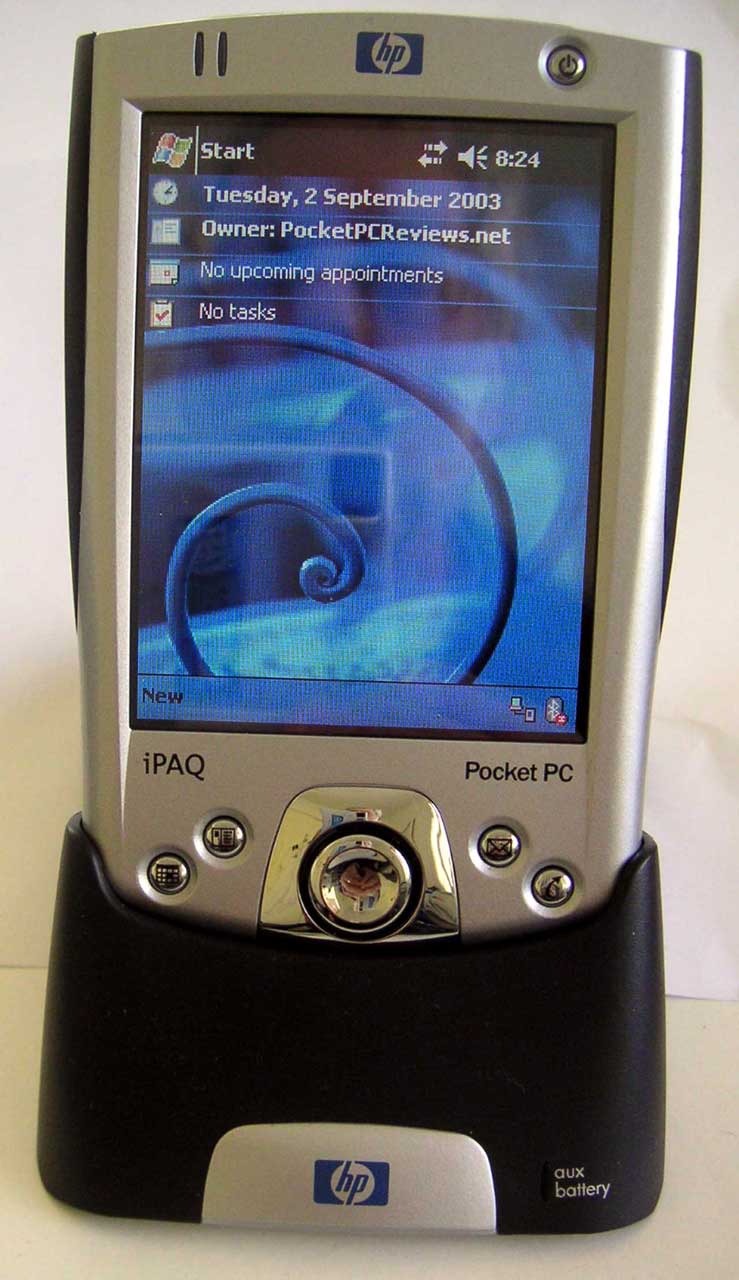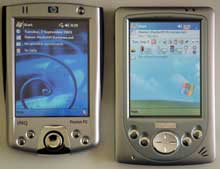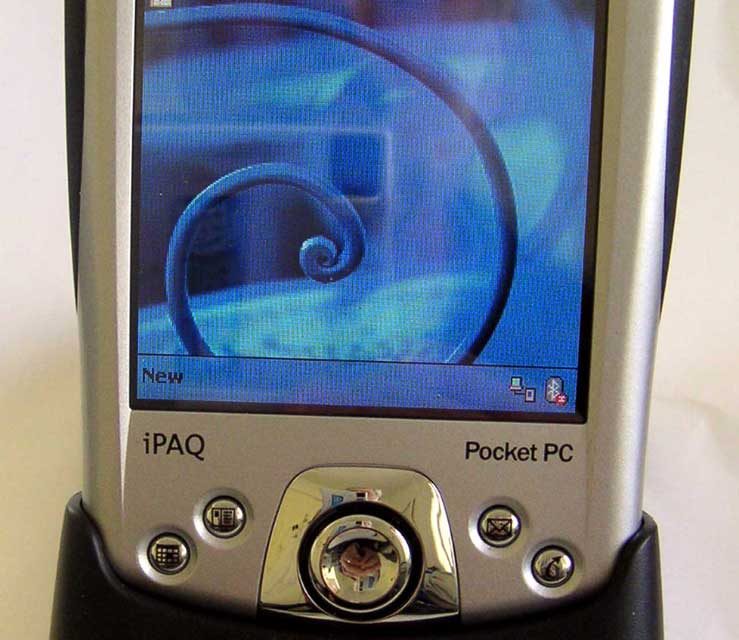
When you’ve been a PocketPC user for some years and have gone through several models you tend to develop a keen sense of what would be the ideal PDA for you.
In checking out the hp iPAQ 2210 did I come close to the ultimate machine?
Very close.
Let’s make it clear from the outset: my requirements for a PocketPC may be totally different from yours but you can’t argue with the specifications and price of this 3970 replacement. With the new Windows Mobile 2003 this is one feature-packed performer!
We’ll give you the objective benchmarks and specs later but first I’ll regale you on why this fourth generation iPAQ appeals to me so much.
Firstly, I almost always carry my PocketPC with me. The bulkiness of a sleeved 3970 in a sturdy leather case has been weighing me down a bit. I like the small-is-beautiful form factor. And with the built-in CompactFlash slot you don’t need any sleeves either.
Secondly, my pet peeve with all the earlier “naked” iPAQ models was that they were very slippery. Sure, the smooth metallic sides may have looked cool when they first came out but practical??
A broken screen is a broken dream, I reckon, and that’s why I even rubberised some sleeves on the 3000 series to give a more comfortable grip. To its great credit the 2200 series come with a very nice and stylish black rubber edge on the sides.
Thirdly, I have already invested quite a bit in the iPAQ line of PPCs. Whilst I cannot use the sleeves any more, other peripheral equipment will still work fine.
|
|
 |
 Before we start testing let’s see how complete the shipment is. This is what you’ll find in the box with the 2210 or 2215.
Before we start testing let’s see how complete the shipment is. This is what you’ll find in the box with the 2210 or 2215.
(I just wish they would stick to one number no matter what country or channel they use to sell the unit through!):
-
900mAH lithium ion removable/rechargeable battery
-
AC adapter
-
USB desktop cradle/charger
-
slip case
-
getting-started guide
-
hp iPAQ PocketPC companion CD

Features and Specs
If you are upgrading from one of the earlier iPAQ models you’ll love the transflective display which is standard for all new PDAs. There’s no comparison with the reflective screen of the first two generations.
The transflective displays reflect ambient light to illuminate the screen, resulting in some power savings, and, best of all, a truer and brighter range of colours. The older reflective screens don’t have the same colour saturation and look washed out. The 2210’s brightness and clarity is a joy to work with and the iPAQ displays are probably the best in the market. There is a difference in overall brightness (see for instance my earlier review on the Toshiba e350).
In keeping with the compactness of the whole unit, the 2210 has a 3.5 inch screen (still 240 X 320 pixels), slightly smaller than the 3.8 “of the older models and the 5000 series.
Missing is the ambient light sensor for automatically adjusting the screen’s brightness. I have never liked that feature as it was changing the backlight just about all the time but what I would prefer is a backlight control that can be manipulated with the joypad. Any developers out there with plans for such a utility? (I use Battery Pack’s brightness slider most of the time but find that too fiddly – particularly when you’ve just switched off the backlight while minimising it and can’t find the icon in the dark to switch it back on!)
The 2210 does have a ClearType tuner, giving you control over the sharpness and colour aliasing of text.
Let’s do a tour of the outside of the 2210.
You’ll notice the absence of a Record button (normally located near the top of the left-hand side).
Rest assured, the unit has the standard voice recording facilities but you’ll have to map one of the four hardware buttons for it. This is where a program like DoubleLauncher shines as you can assign more than one function to a button. I do believe that with this model hp should have included a functionality like that.
Also missing is a jog wheel… (not that it has ever been on any of the iPAQs but it’s a great feature on the Toshibas and MiTACs, so here’s hoping!)
The joypad or D-pad is precise with the right amount of tactile feedback.
I’ll be missing the distinctive, oval D-pad which has become the hallmark of this website!
Mine will stay, though!
The slots on the top accommodate the SDIO or MMC cards which are great for additional memory and the bigger slot will house any CF accessory or memory card. The dummy insert in this slot blends in so well with the rest of the device that, at first, you wonder where is that slot??
This model is equipped with Bluetooth (more about that later) and no doubt iPAQ will come out with a WiFi model soon as well but in the meantime the CF slot will take a WiFi card.
Invisible on our walk-around is the IR facility, hidden behind that black plastic on the top. This is the same industrial-strength (or officially: consumer-grade) IrDA transmitter which you had on the 3970. Yes, and finding NEVO wasn’t hard either as this brilliant remote control program is included in the fairly extensive list of software.
On the top-left corner are 2 LED’s, one amber for events, charge, etc. and a blue one (bluetooth) as well as the standard 3.5mm audio jack.
On the back of the 2210 we find the battery compartment (removable) and the speakers.
It is probably the best place for the speakers from an engineering point of view and although the sound quality is quite decent, when the unit is mounted the sound is somewhat muffled. Maybe we should have an additional little tweeter in the front!
Having a mounted iPAQ leads to another discovery: the reset hole is also located at the back. Not smart if you have to take out the whole shebang to poke that hole when the unit stuffs up. This has not happened so far but was a common occurrence on all the older models! Maybe we should have another soft-reset capability by pressing just the two outer buttons…
 |
|
|
Battery and Endurance
The 900mA battery is user replaceable, which means you have about 10 mins to put in a new one before data is lost so you’d better be quick on the draw! In most cases recharging it is the better option but for years iPAQ users have been clamouring for replaceable batteries and we shouldn’t complain now either. No, it’s an excellent option to have.
I have run some test with Spb’s BenchMarking software, a reviewer’s best friend.
The best endurance we got was 4 hours and 18 mins, using full bright screen and giving the CPU some decent workouts.
It’s better than the 2:42 hours I got out of my 3970 and with judicial use of backlight and adjusting the point where your machine goes into “standby” mode to preserve your data, you’ll get a decent working day out of it yet.
Battery endurance is directly related to the use of backlight and how much the 400 MHz PXA255 Intel XScale processor has to work. This CPU is ideally matched with the new operating system which will make full use of optimising speeds – particularly if the programs themselves have been optimised for use with XScale processors. Most people will just be happy to see this machine fly, which it does (quite literally too as we took it for a test flight with our charter aircraft – more about that later too).
The only other thing worth mentioning at this stage of our inspection tour is that iPAQ stuck with the connector that was introduced on the 3800 series and which some other manufacturers, like MiTAC, have adopted as well. Would be nice if we had some standards here just like the USB connectors – although, come to think of it, there are too many variants here as well!
Memory on this model is nothing special but quite adequate: 32 MB ROM, 64 MB RAM. (57MB of RAM are available to the user to run and store applications and 3 MB of ROM is available in the iPAQ File Store as well.
 |
|
Operating Syste
I’ve written before about the two versions of Pocket PC 2003 (or Windows Mobile 2003): Pro for the more basic Pocket PC models and Premium for higher end Pocket PCs. The differences are not really significant. Applications like Windows Media Player are built into the OS stored in ROM in the Premium Edition while you need to install it from the CD into RAM with the Pro Edition. I think Microsoft could have saved themselves some confusion here.
This demonstration unit came with the Premium Edition. See list at the end of this review for what’s included on the CD.
With the new Bluetooth Manager, which takes the wizardry of making connections to a new level, it’s almost easy now to hook up wirelessly to computers and GPS receivers.
As usual, I tested this iPAQ in our pressurised Centurion with several navigation programs. With the bluetooth GPS it makes an excellent moving map platform. I also discovered that the old sleeves still are useful as a holster: the new iPAQ can slide quite snugly into these sleeves which means that I can have an old sleeve permanently connected to the yoke mount and just slip in the unit!
|
|
|
High Marks:
· Compact form
· Excellent display
· Fully featured (dual slots, bluetooth, IR remote control)
· Comfortable grip
· Good range of useful software
Marked for Improvement:
· A decent stylus (and keep this one as a spare)
· Boot time after soft-reset is rather long (no wonder they renamed it Windows Mobile!)
VfM (Value for Money) rating: very high.
|
|
|
Conclusion
Unless you need/want biometric security, built in WiFi, more internal memory or the older form factor for compatibility with other equipment which the 5000 series provides, this iPAQ model is as much PDA as most people will need.
It simply is the best implementation of a compact PocketPC that I’ve come across so far. Highly recommended.
Suggested list price USD 399
Australian RRP: AUD 799
Spb Benchmark Indices
|
1140.97 |
|
|
1790.58 |
|
|
1113.26 |
|
|
563.87 |
|
|
1058.78 |
Main test results:
|
818 ms |
1252 KB/sec |
158% |
|
|
37.7 ms |
26.5 MB/sec |
146% |
|
|
816 ms |
1254 KB/sec |
159% |
|
|
1147 ms |
893 KB/sec |
159% |
|
|
104 ms |
9.58 MB/sec |
151% |
|
|
1293 ms |
792 KB/sec |
166% |
|
|
103 ms |
19.4 thousands of files/sec |
16% |
|
|
725 ms |
1380 records/sec |
327% |
|
|
19.3 ms |
51.8 frames/sec |
192% |
|
|
44 ms |
22.7 frames/sec |
168% |
|
|
16.8 ms |
59.6 frames/sec |
28% |
|
|
7150 ms |
36.4 KB/sec |
118% |
|
|
3129 ms |
7.91 KB/sec |
60% |
|
|
1230 ms |
206 KB/sec |
391% |
|
|
3627 ms |
551 files/sec |
107% |
|
|
4501 ms |
225 KB/sec |
212% |
|
|
469 ms |
599 KB/sec |
188% |
|
|
19.5 ms |
51.3 frames/sec |
47% |
|
|
4861 ms |
0.077 Mop/sec |
166% |
|
|
1136 ms |
55.4 Mop/sec |
163% |
|
|
9963 ms |
5.02 Mop/sec |
169% |
|
|
9.56 ms |
105 MB/sec |
149% |
Table of results
|
|
Compaq iPAQ 3970 (2002, 400Mhz) |
iPAQ 2210 (2003, 400Mhz) |
|
846 |
1141 |
|
|
855 |
1791 |
|
|
855 |
1113 |
|
|
785 |
564 |
|
|
638 |
1059 |
|
|
656 |
1252 |
|
|
15.7 |
26.5 |
|
|
710 |
1254 |
|
|
480 |
893 |
|
|
5.36 |
9.58 |
|
|
379 |
792 |
|
|
118 |
19.4 |
|
|
380 |
1380 |
|
|
19.9 |
51.8 |
|
|
11.3 |
22.7 |
|
|
175 |
59.6 |
|
|
21.3 |
36.4 |
|
|
4.73 |
7.91 |
|
|
82.4 |
206 |
|
|
210 |
551 |
|
|
62.7 |
225 |
|
|
406 |
599 |
|
|
89.3 |
51.3 |
|
|
0.061 |
0.077 |
|
|
55.1 |
55.4 |
|
|
3.97 |
5.02 |
|
|
56.2 |
105 |
Specifications:
Software Included In ROM
-
Pocket Outlook 2002
-
ActiveSync 3.7
-
Pocket Internet Explorer
-
Pocket Word
-
Pocket Excel
-
Block Recognizer
-
Voice Recorder
-
Calculator
-
iPAQ Task Manager
-
Diagnostic Tool Kit
-
iPAQ Backup
-
iPAQ Image Viewer
-
Nevo (Universal Remote Control )
-
iPAQ File Store
-
Utilities such as Self Test, iPAQ Audio, Power Status, Adjustable Standby Settings
-
Windows Media Player 9 for Pocket PC
-
Microsoft Reader for Pocket PC
-
Games: Solitaire & Jawbreaker
Optional Applications (and demos) on CD:
-
ActiveSync 3.7
-
Microsoft Outlook 2002
-
Lotus Notes
-
Audible for playing audiobooks
-
RealOne Player
-
Adobe Acrobat Reader
-
Bundled 3rd party software (some only trial versions) includes RealOne Player, AvantoGo!, ListPRO, XcelleNet’s Afaria, HP Mobile Printing for Pocket PC, Westtek’s ClearVue Office Suite which allows you to view native Word, Excel and PowerPoint files without conversion, eWallet, F-Secure FileCrypto, iPresentation suite for PowerPoint slide shows and PocketWatch.
Hardware Specifications
- Operating System: Microsoft® Windows® Pocket PC 2003 Premium
- Processor: 400 MHz Intel® XScale technology-based processor
- Memory: 64 MB SDRAM (56 MB main memory)
- Display: 16-bit Transflective TFT colour (65,536 colours) 240 x 320 pixel 3.5 in (96 mm) diagonal
- Expansion: SD slot: SD, SDIO, and MMC support, CF Slot: Compact Flash Type I and II
- Infrared port: IrDA SIR
- Integrated Bluetooth™ (ver. 1.1)
- Battery: Rechargeable 900 mAH Lithium-Ion user swappable battery
- AC Power: AC Input: 100~240 VAC, 50/60 Hz; AC Output Voltage: 5V DC Output Current: 2A
Dimensions: (L x W x H) 4.54 x 3.00 x 0.61 in. (115.4 x 76.4 x 15.4 mm)
Weight: 5.1 oz (144.2 g)










